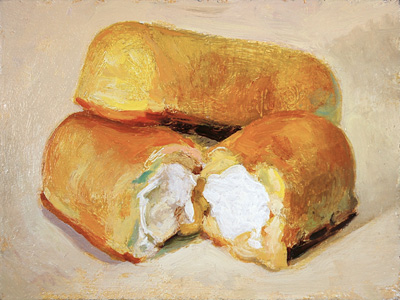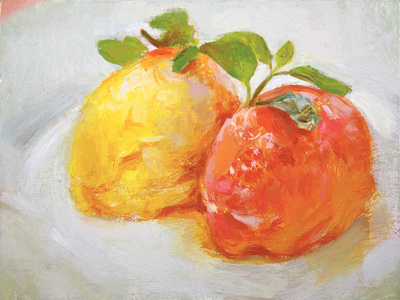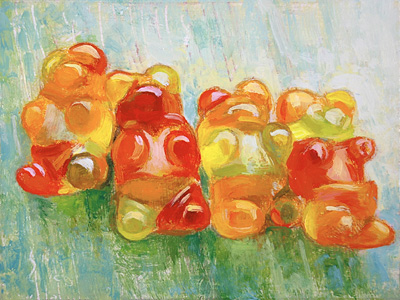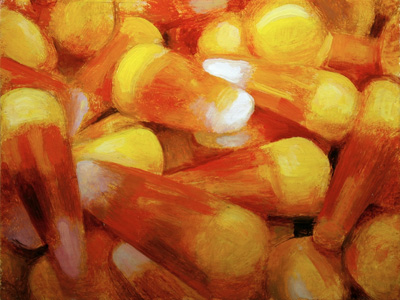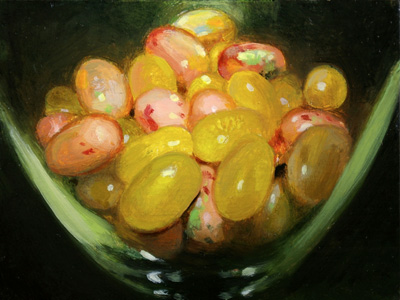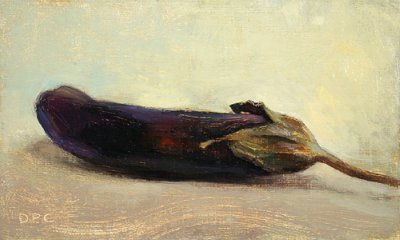
7/24. Mini Eggplant, oil on linen on panel, 3x5 in.
Another old one, out of order. I don't know why I didn't post these eggplant pictures. I really like this one—I think I was able to really stay connected and aware, or, I think the way my friend Gary once put it, to do the best painting I could at that particular moment.
Saturday, December 13, 2008
Mini Eggplant
Posted by
Dan P. Carr
at
9:05 PM
7
comments
![]()
Tags: daily painting, food
Eggplants
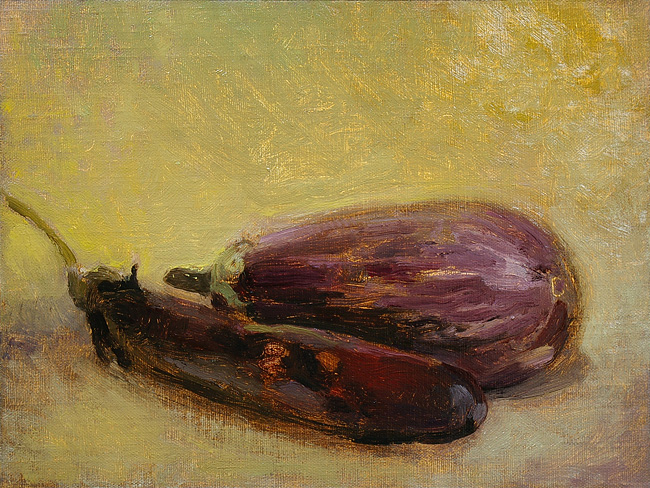
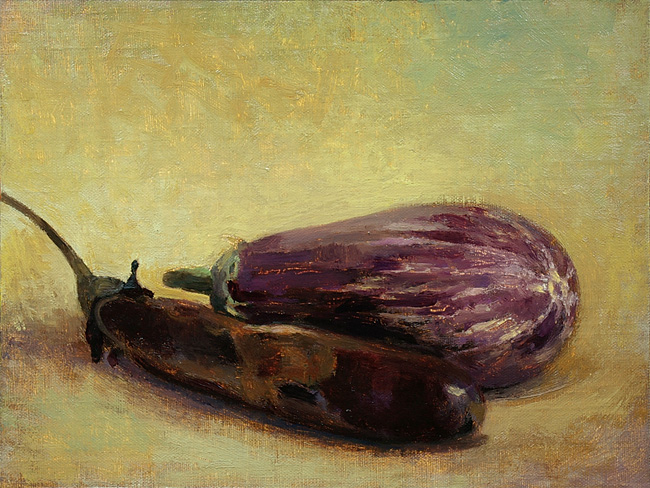

7/23. Eggplants, oil on linen on panel, 6x8 in.
A piece from way back in summer before the mango, done over several nights. (What I remember is,) the first night I couldn't really get into it, partly because the big eggplant had a coloring that was a cooler purple than the skinny one and that I had trouble zeroing in on; moreover, I couldn't figure out how to "draw" the complicated striping on the big eggplant.
On the big eggplant especially, I found myself going back and forth between rendering form (the dullish, even spread of light) and surface gloss (the clean, juicy shadow tones), which process was complicated again by the busy stripy pattern.
The second session was either the next night or two nights later, and the third session a few nights after that, so that the skinny eggplant (which was already getting mushy) had enough time to undergo some natural transformation. A few of these "changes" I left out because they were either difficult to add on top of what I had already painted or because they were simply very unappealing. My backdrop must not have been simple or solid enough because I played around with some different colors (blues, greys) and was unsure how to keep it.
At some point I had gotten a tube of aureolin (cobalt yellow) because Williamsburg and others mention its use "in some of Turner's skies." I had taken to using Indian yellow because of its transparency but wondered how the cooler aureolin would work (good enough for Turner!), so I tried some of it in the yellow background at the third stage. I found it to be much greener than I would have liked and spent a lot of time trying to undo the experiment (it's quite strong), perhaps overcorrecting towards the too-hot—and making another example of excessive chroma syndrome, or whatever they call it. I don't dislike it though; and as far as the baffling stripy pattern goes, I was satisfied enough with the somewhat impressionist treatment of it (good enough for me).
Posted by
Dan P. Carr
at
7:30 PM
8
comments
![]()
Tags: art supplies, daily painting, food, work in progress
Friday, November 7, 2008
Cream
"Lawdy Mama," 1967 (outtake from Disraeli Gears, later released on Live Cream). Jack Bruce, bass; Ginger Baker, drums; Eric Clapton, guitar and vocal.
So smooth. These guys truly were the cream of the crop, each complemented the others perfectly. I love this – the perfect vocal timing, the masterful strutting beat, but perhaps most of all Jack Bruce’s expert bass playing, which supports Clapton then subtly emerges at the surface in places with something unexpected. Functional, I suppose, but never pedestrian, though I’m no expert (and yet arguably there were some cases, e.g. the famous live "Crossroads," where Bruce outplayed Clapton).
If you are somewhat familiar with Cream you may notice the similarity here to the song "Strange Brew": their producer, wanting something more trippy and pop than a white-man’s-blues rendition, put a new vocal and guitar track from Clapton over the existing bass and drum parts. From what I gather Bruce wasn’t around to supply a revised bassline and was unhappy (understandably?) with the result.
I don't know what the equivalents in painting would be to the layers in a musical piece, but I think of a great bassline as something like the imprimatura or primuersel that shows through in a painting, whether visible in transparent passages or in parts left exposed outright (see Rembrandt). In the best cases it doesn't immediately jump out and smack you in the face.
[Credit to the original posters.]
Posted by
Dan P. Carr
at
8:36 PM
2
comments
![]()
Tags: miscellanea, music, videos
Tuesday, November 4, 2008
Friday, October 3, 2008
A Lightfast Alizarin
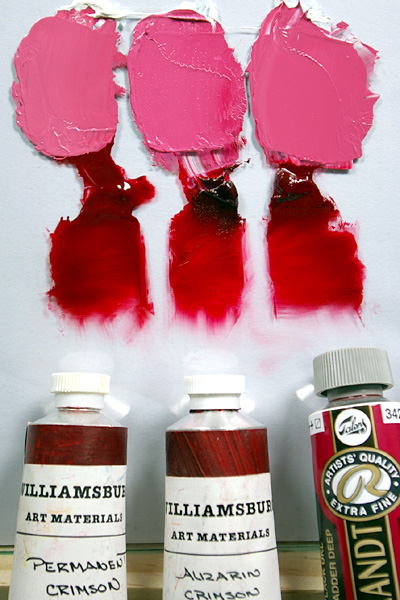
I finally decided to replace my Alizarin Crimson, which is only moderately lightfast (not that I ever really use it by itself in thin layers). I love the Alizarin by Williamsburg (dihydroxyanthraquinone, PR 83) and wanted to give their substitute a chance as I now go with them for all but one of my palette colors, so I tried their Permanent Crimson (anthraquinone, PR 177), which is described as an "absolutely permanent, lightfast substitute for Alizarin Crimson." Very disappointingly, Gamblin's Alizarin Permanent is made from a mixture of quinacridone red b (PV 19), perylene red (PR 149), and ultramarine (PB 29), so I'm not bothering with that. I read recently in at least three places that a truer substitute for the traditional Alizarin or madder hue is pyrrole ruby pigment (PR 264), which can be found in Rembrandt's Permanent Madder Deep (among others), so I got a tube to check it out.
Here I mixed a tint of each one with titanium white. I was afraid a photo would flatten any hue difference between the pigments, but except for the Permanent Crimson which seemed the tiniest bit warmer (this would create slightly less purple purples if you know what I mean), there was little hue difference for the camera to flatten. And all three pigments are strong-staining and have that lovely pinkish undertone. In masstone, however, the substitutes clearly don't match the Alizarin, in center, which is beautifully deep and dark as a thick pile (it almost resembles here a bleeding scab). The substitute Williamsburg, at left, feels flat, with little difference between its masstone and undertone. The Rembrandt pigment, while not an exact match, shows at least some of that Alizarin-like deepening as it gets thicker. Such deepness might not factor much in my normal painting work but it was something I was happy to see, so for this along with its excellent berry-juice-like quality overall, I'm going to try using the Permanent Madder Deep as my Alizarin substitute.
Posted by
Dan P. Carr
at
1:46 AM
6
comments
![]()
Tags: materials, miscellanea, palette
Thursday, October 2, 2008
"The Exquisite Still Life" show, Salem, Oregon
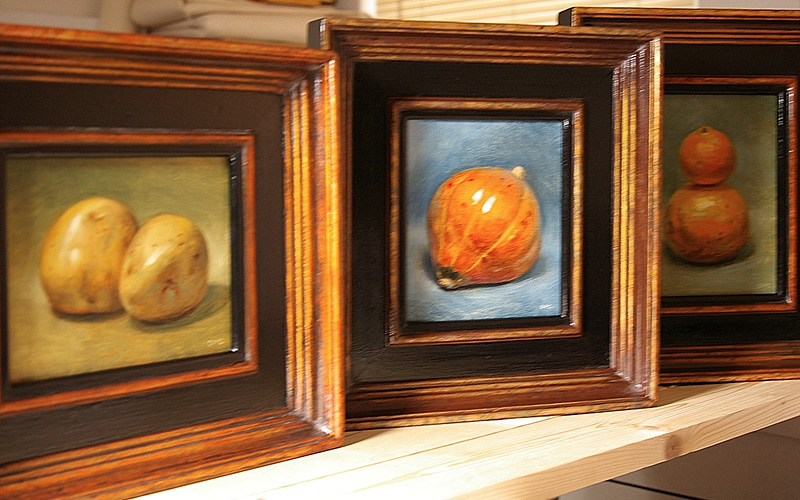
The other day I sent out nine pieces for an exhibit titled "The Exquisite Still Life" at Chemeketa Community College in Salem, Oregon. Also showing will be Oregon painters Lisa Caballero, Bobbie Jansen and John Van Dreal, so I was surprised and delighted when asked several months ago to participate, being all the way out here on the opposite coast. The show starts this coming Monday the 6th and runs through the 31st, with a reception on Wednesday the 8th from noon to 2 pm. If you live in the area please come.
Posted by
Dan P. Carr
at
10:03 PM
9
comments
![]()
Tags: miscellanea, shows
Wednesday, September 10, 2008
Mango #2, and Color in Old English (Part 3)
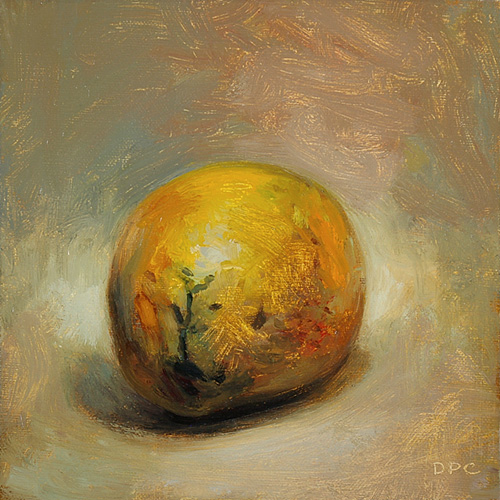
7/30. Mango #2, oil on linen panel, 5x5 in. SOLD
I had long wondered what was meant by "red gold" in medieval literature. Was it, like so-called red or rose gold today, simply a colored gold alloy? If not, why was it called red? Of course, the answer to this might have to do with what the color "red" once meant.
A cursory explanation was offered by Nigel Barley in "Old English Colour Classification" (Anglo-Saxon England 3, 1974). His theory of Old English colors states that they were centered on a light-dark axis, and that a few colors had derived from ancient horse color terms (which Earl Anderson would later elaborate upon) - these special colors were normally used of "animate" things, or else to describe some other-dimensional aspect of an object's surface. But despite this over-ruling ancient "binary opposition" of light and dark, hues sometimes were distinguished, even if, on the hue axis, the Old English colors didn't line up with our modern color system. Barley gives a table, like the one below, that shows "how simple is the solution to that most perennial of old disputes in Anglo-Saxon - the use of read to describe gold" - we see that the Old English colors read and geolo once lay in different places on the spectrum from those of modern English "red" and "yellow":
..Modern English....Old English
.________________ ________________
(................!................)
(......blue......!................)
(................!.....hæwen*.....)
(————————————————!................)
(................!................)
(.....purple.....!————————————————)
(................!................)
(————————————————!.....baso*......)
(................!................)
(......red.......!————————————————)
(................!................)
(————————————————!.....read.......)
(................!................)
(................!————————————————)
(.....yellow.....!................)
(................!.....geolo......)
(................!................)
(————————————————!————————————————)
(................!................)
(.....green......!.....grene......)
(________________!________________)
*Hæwen and baso were not basic-level color words.
Barley writes, "Recourse is often had to highly ingenious and learned explanations urging that gold in medieval times had a relatively higher copper content and that it was consequently redder than modern gold. We are told that the adjective was used only for the alliteration or because it had become a set phrase. As elsewhere, such explanations lack an anthropological perspective and so fail to realize that Old English 'red' is not our red and that we cannot blandly equate the two categories." While Barley's explanation considers the "variation from culture to culture in the position of boundaries," Earl Anderson suggests we also determine the possible focal point of the color red in Old English. He writes,
"Contributing to the reputation of 'red' as the color par excellence is the extraordinary stability of *rudhró- (together with its northwest variant *rowdhó-) in the Indo-European languages," he says; *rudhró- possibly is a loanword from Sumerian urudu 'copper' from Sumerian *burudu, "which gave the Euphrates river its ancient name[.]" The connection to copper or ore can be found in Latin raudus, pl. rudera "piece of copper, copper coin," Russian ruda "ore." *Rudhró- is found in the Greek erythros and Latin ruber. The variant *rowdhó- appears in Baltic, Celtic, and Germanic languages, e.g. Lithuanian raudas, Old Irish ruad, Welsh rhudd, Old Norse rauðr, and Old English read (and noun rudu "redness").The virtual universality of 'red' as a semantic category is a linguistic by-product of the artistic and ritual use of ocher among primeval human cultures the world over. Ocher is a clayish soil containing hydrated oxide of iron, with colors that include yellows, reds, and browns. Iron ore is found also is found in the purer forms of red hematite and yellow-brown limonite. Ocher, hematite and limonite in pulverized form often were used as pigments by ancient man. The colors of these ores can be intensified and darkened by heating them and by mixing them with water or with some other liquid.... The material culture, ... considering the early importance of ocher in it, may very well be the motivator of 'red' as a basic color term in languages around the world.
Anderson goes on, "In the Iliad, [erythros] is used for the color of copper as well as of blood, wine, and nectar.... For speakers of contemporary European languages, 'red' has its focal point in the color of fresh blood. We should take care, however, not to project this intuitive knowledge of red onto languages other than our own, for blood, copper and ocher all are possible candidates as the material basis of red." So red might have been more earthy than we are used to today (and possibly why Aristotle was against describing the dawn as erythros). The problem of "red gold" is made more puzzling, says Anderson, by the fact that "gold" (Germanic *gelto-) was derived from "yellow" (*gelwoz), but that it is
modified by 'red,' not by 'yellow' until later medieval times. [The 14th-century poem Wynnere and Wastoure has the phrase ȝalowe golde.] This certainly differs from the situation in the sixteenth century, when Thomas Cooper (1578) defined the verb flaveo, 'to be yelow, or of colour lyke golde,' and ... when Samuel Johnson, in his Dictionary (1755), defines ruddy as 'Approaching to redness,' and then gives, as a second meaning, 'Yellow. Used, if at all, only in poetry.' Johnson was thinking of Dryden's line, 'A crown of ruddy gold inclosed her brow,' a relic reminiscent of the Old an Middle English ways of describing gold, which by the eighteenth century had become forgotten to the extent that he didn't know what to make of it.
The modifying phrases used in Old Norse are raut gull 'red gold' and bleikt gull 'bright gold' (cf. OE blac [easily confused with blæc "black"]); Old Norse also has raud mani 'red moon' and et rauða 'egg yolk.' Among the twenty-eight times that read- is used in Old English poetry, the phrase read gold appears four times. Read- modifies gold about twenty-one times in the Old English corpus, and it modifies blod about twelve times.... Among the fifty-four times that rot 'red' appears as the most frequent color word in the Middle High German Nibelungenlied, eighteen times it modifies golt.
Anderson discusses the proposed solutions to this puzzle:
(1) The meaning of "red" was indeterminate. Some in the 19th century believed that primitive Germanic peoples had an underdeveloped capacity to see color, hence "red" could be used to describe gold. But this doesn't explain why gold could not also have been described as "yellow."
(2) "Red gold" was merely a poetic convention. This theory, mentioned by Barley above, was just an extension of another 19th-century idea that the severely limited palette of the Iliad and Odyssey was a stylistic choice. "It is true that read gold is a verse formula, always appearing as a b-verse in Old English poetry; but beyond the poetry, read modifies gold sixteen times in prose or in glosses ... [and those examples] are not confined to any one formula. Moreover, the phrase 'red gold' continues to be used in Middle and early modern English, long after the potential influence of oral poetic tradition."
(3) Also mentioned by Barley is the theory that the gold of the Middle Ages "was often darker than that of our own, and contained a considerable alloy of copper," as W.E. Mead wrote ("Color in Old English Poetry," 1899). Anderson says that gold objects from medieval China do tend to have a reddish color, and that in Europe, since the time of the late Roman Empire, "the gold used in coinage often was alloyed with copper, but this was not normal practice for gold used in manuscript illustrations and for jewelry or precious objects." Although Anglo-Saxons only rarely used gold in manuscript illustration before 900, "[later] artists sometimes used it generously, and when they did, they used highly burnished gold, not only for incidental details, in a picture, but non-naturalistically to sectionalize or unify or frame a picture, and to brighten it." And while an inventory of Anglo-Saxon metalwork would indicate a number of gold-copper alloy objects, Anderson believes that
(4) L.D. Lerner, in "Colour Words in Anglo-Saxon" (Modern Language Review 46, 1951), had said that read was one of several color words (including brun, græg, and fealo) relating to brightness (or shininess?) rather than hue - so that read gold really meant "bright gold." This was just a revival of the theory that primitive peoples had a limited "color sense," and of theories like Mead's which describe an ancient preoccupation with light-dark contrasts - so that hwit often meant "bright" instead of "white"; brun when applied to metal meant "bright" with, as Mead says, "a suggestion of redness"; fealo of weapons meant "bright" and slightly yellow; etc. Barley argues the same point when he writes that the color system stressed brightness over hue. But, says Anderson,the Anglo-Saxons were more likely to safeguard the integrity of gold because of its greater value. In some prose texts, indeed, read as a color-modifier suggests the purity and brilliance of gold rather than its adulteration with base metals. This is the case with an anonymous homily De sanctio Iohanne:
Þu gelitenest swa read gold, ealra fugela king, Fenix gehaten
[You shine like red gold, king of all birds, called Phoenix]... and again [in Ælfric's Catholic Homilies I] when St. John transforms a bunch of green branches into golden rods:
ealle þas goldsmiðas secgað þæt hi næfre ær swa clæne gold ne swa read ne gesawon
[all the godsmiths say that they never before had seen gold so pure and so red]
However this may be, the range of referents modified by read in Old English is such that the word in itself could hardly imply 'brightness,' although it is true that bright things, like the sun or the sky or gold, and maybe even blood and wind, could be red. Among the items often described as read in charters are topographic features such as rocks or stones, especially boundary stones (17 occurrences), cliffs (7), ditches (8), a ridge (2), a path or road (14), a slough or wallow (7), a spring (5), stream (6), ford (7), or pool (3). Read, when applied to these referents, evokes an earthen or mineral color.(5) Barley's solution, as we saw above, was that the places "red" and "yellow" occupied on the color spectrum were different from where we would put them today, so that gold was called read and not geolo.
(6) Another possible solution is the theory that
'red,' the color par excellence, has a close semantic association with 'color' in the sense of a 'covering,' exemplified by gilt, paint, or, in paleolithic and neolithic times, by fine red ocher dust sprinkled over a body in a funeral. In the phrase read gold, the essential idea is that gold is a covering; its chromatic value is secondary. For this reason, 'red' is preferred to 'yellow' as a modifier for gold ... In some languages, it is true, the taxonym for 'color' also means 'red': ... [e.g] Spanish colorado 'reddish.' In ancient and medieval Europe, red was a symbol in malo of evil, of the devil, and of a dreadful disease called "St. Anthony's fire" in the Middle Ages and Renaissance ... whereas in bono, red had protective power against evil.... According to this line of reasoning, red, as the color of blood, has a special association with sorcery or magic or the supernatural or the universal life-force and thus could extend to gold, the best of all metals.But, although English "color" was a loanword from Latin color (rooted in celare 'to conceal'), the "closest semantic counterpart to color in Old English ... is hiw, which means 'color,' 'shape,' or 'appearance' but not 'covering.'" And with regard to magic or a universal life-force, Anderson says
the symbolic role of blood is ambiguous in medieval iconography. The wine ceremoniously consumed at communion symbolizes and becomes Christ's blood, shed at the time of the crucifixion as the basis of mankind's salvation. On the other hand, it is a medieval scientific commonplace concerning the blood of animals that 'heora blod is heora lif' [their blood is their life (Ælfric's Catholic Homilies I)], in contrast to human beings, for whom life consists in the soul rather than in blood. There is, after all, then, no particular connection between 'red' and sorcery or the supernatural in Old English.
Of these six possible solutions to "red gold," Anderson says that Nigel Barley "is right if all he means to say is that the Anglo-Saxons thought of gold as read rather than geolo." Anderson suggests a "larger theory," that
Anderson notes that information about relative frequency doesn't say much about the focality of read, but rather the subject matter of the material in which we find the word: the read paths and boundary stones mentioned in charters, the colors used in scientific texts, and the many references to the Red Sea in religious works are all "out of proportion to the probable use of read in the ordinary speech of the Anglo-Saxons. With respect to semantic range, however, [this information] encourages the belief that 'earth tones' are a canonical part of read."Old English read and its early Germanic cognates preserved the semantic range of Indo-European *rudhró: the colors obtainable through the artistic preparation of ocher and hematite: red, reddish brown, orange, and reddish yellow. The reason for 'red gold' rather than 'yellow gold' is, quite simply, that read is mainly earthen, mineral, or metallic in its focus, whereas geolo focuses mainly on the colors of vegetation, and resembles grene in this respect.
The conceptual challenge that 'red gold' offers has two parts: the semantic range of 'red' is comparatively restricted compared to Old English read. 'Orange,' 'pink,' 'purple,' and 'gold' are basic colors in contemporary English, and thus are sharply differentiated from 'red.' In Old English, in contrast, these colors belong to the semantic range of read.... Leaving aside the biblical hydronym read sæ [Red Sea] which is just a translation of Mare rubum, the most frequent referents are topographic features such as cliffs, rocks, ridges and paths, streams, ditches, pools, mires and wallows, and herbs and nettles. The referents include blood, apples, peppers, grapes, clover, lips, the uvula, bodily wounds, and, of course, gold.
In modern English, as noted earlier, the focal point of 'red' is something like the color of fresh blood, therefore we may tend to think that blood was the prototypical referent of 'red.'
It is quite possible, however, that the prototypical referent of the Indo-European word for 'red' was ocher, the earliest mineral-based pigment to be used universally by mankind. OE read was, in other words, essentially an earthen color, at least originally. The possible focal points include reddish brown, orange, and reddish yellow; the bright red of fresh blood is possible but improbable. At some early point in their history, the Indo-Europeans learned the use of copper as it spread from Sumer to other parts of the Fertile Crescent and beyond, and at that time, ocher may have been displaced by copper as the focal point of 'red'; this new foreign influence on the material culture may have found expression, as well, in *rudhró- based on the same root as Sumerian urud 'copper.' No doubt the focal point and range of this word varied in time and place among Indo-European dialects, affected by changes in the material culture such as the introduction of shellfish or plant-based dyes and advances in medical and metallurgical technologies. It is impossible to prove that the focal point of OE read was something other than the color of blood, but two arguments favor this position:
(1) Of more than 260 appearances of blod- in Old English texts, it is called read fourteen times, and once rudig. Read is the color word most often used to modify blod, but fah~gefah, and sweart are also used....
(2) In the Old English Lapidary ... periphrastic descriptions of the blood-like colors of sardonyx [blode licost "most like blood"] and sard [luttran blode gelic "like clear blood"] are used, rather than read. If fresh blood were the prototypical referent of Old English read, one might have expected a phrase like *read blode gelicost, or possibly blodread which appears four times in Old English ...
These arguments are inconclusive, at best suggesting that we cannot draw firm conclusions about the focal point of OE read. It is possible that read has two focal points, one the color of freshly drawn blood, and the other a mineral color like gold - just as modern English blue has two focal points. We cannot be certain about that, but we can be certain that read was a basic color word whose semantic range included red, orange, pink, gold, and purple.
Posted by
Dan P. Carr
at
11:37 PM
1 comments
![]()
Tags: books, daily painting, food, history, Middle English, Old English, poetry, translation, words
Saturday, September 6, 2008
Williamsburg Paints on eBay!
For anyone who is interested, I got a bunch of Williamsburgs recently at a great price and have just put them on eBay. Click on the big fancy sidebar link!
Posted by
Dan P. Carr
at
12:16 AM
2
comments
![]()
Tags: miscellanea
Wednesday, September 3, 2008
Color in Old English (Part 2)
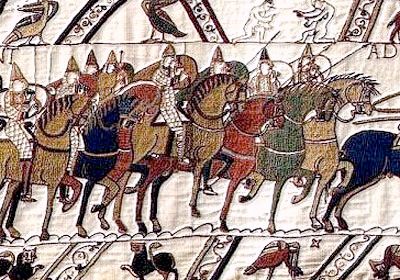
hiw - shape, appearance, as well as colorbleo - complexion, appearance, and form as well as colorfah - stained, guilty, criminal, shining, and variegated as well as colored
Is se fugel fæger__forweard hiwe,
bleobrydgum fag__ymb þa breost foran.[The beautiful bird is foremost in color (or: appearance or shape), colored (or: adorned) with variegated colors in front, around his breast.]"
So, what about the actual color names themselves? After exhaustive reconstructions of the color taxonomies of Proto-Indo-European, Greek, Latin, and Germanic, Anderson concludes that Old English had (like Germanic) six basic color terms:
BLACK - sweart, with the innovation of blæc as a rival synonymWHITE - hwit
RED - read
GREEN - grene
YELLOW - geoloGRAY - græg
It is a misconception widely held that cross-linguistic variation in color vocabularies results from differences in the ways 'color space' is divided from one language to another. The chromatic spectrum, according to this view, is a continuum without breaks, but languages use basic color words to divide up the spectrum in different ways. If this were so, we should expect speakers of a given language to agree as to the 'boundaries' between one color and another. This was not the case, however, in tests in which speakers of American English and Dani were asked to identify an assortment of color chips as exemplifying one color or another. Neither the Americans nor the Dani could agree among themselves as to the boundaries between yellow and green or green and blue [Eleanor Heider, "Universals in Color Naming and Memory," Journal of Experimental Psychology 93, 1972]. This leads to the conclusion that the boundaries between one color and another are idiolectic [different from person to person]. As Mead observed seventy years earlier, 'Most of us have a very limited color vocabulary, and we differ hopelessly in our terminology as soon as we move away from a few sharply defined colors[.]'
What Mead was getting at [in saying "we differ hopelessly in our terminology"], putting his native speaker intuition to good use, was the primacy of color focalities rather than color boundaries. The notion of color vocabulary as the arbitrary division of color space is disconfirmed by our own experiences.
... [F]or any given language, native speakers agree on the names and focal points of canonical colors. The hypothesis of focal colors was tested by Heider ... who, in the series of experiments alluded to earlier consulted twenty speakers of American English, and twenty-one speakers of Dani, a language that has only two basic color terms, mili for 'brightness' and for 'warm' colors and mola for 'darkness' and for 'cold colors' ... In one experiment, English and Dani informants were presented with color chips that exemplified both saturated or 'pure' colors and unsaturated colors, and were asked to recall the colors. In another, the Dani were asked to learn names for both saturated and unsaturated colors. In these tests, ... both Dani and English speakers named the saturated colors more rapidly, and gave these colors shorter names, compared with nonsaturated colors. Select saturated colors, therefore, are marked as 'focal,' and their focality influences cognition, for Dani speakers as well as for speakers of English, even though Dani has no chromatic color terms.
"It is natural to think of erythros, the basic term for 'red,' as occupying a large semantic space in which phoinikos and rhodos are located as smaller spaces. We would probably want to think of the relationships among modern English terms for 'red' in the same way ...":
'rosy-fingered dawn,' based on the verse formula rhodo-daktylos eos in the Iliad.... In a discussion of diction as an aspect of style, Aristotle notes his disagreement with the sophist Bryson, who says that there is no such thing as bad word choice because one synonym will do as well as another in cases where words have the same referent. Aristotle argues the contrary ... In the case of metaphor, well chosen words are
beautiful to the ear, to the understanding, to the eye or some other physical sense. It is better to say, for instance, 'rosy-fingered morn' (rhodo-daktylos eos) than 'crimson-fingered' (phoiniko-daktylos), or, worse still, 'red-fingered morn' (erythro-daktylos).
One could argue Aristotle was only thinking of the sound of the words [that is, that rhodo-, already part of a Homeric verse formula, was better for having only two syllables and not three like phoiniko- or erythro-] ... But this does not explain why Aristotle regards erythro- as the ugliest of all possible substitutions that he can think of, and this should give us pause, for Aristotle is a reliable witness, and erythros is the basic color term for 'red.' Come to think of it, whenever Aristotle, in Meteorologica, has occasion to refer to redness in the sky, he avoids erythros, using specialized terms such as phoinikos or porphyrios ... and he avoids metaphorically-derived terms such as aimatode chromata (blood-(red) colors) ... For Aristotle, erythros was not a color term that one used in a meteorological context, and for this reason, 'red-fingered dawn' was not available as a possible substitution for 'rosy-fingered dawn.' ... In their analyses of rainbow colors [which is a whole other discussion], Aristotle and Xenophon use phoinikos but not erythros, although a century after Aristotle (c. 260 B.C.), Poseidonios uses both phoinikos and erythros. Perhaps erythros in earlier Greek was focalized on a mineral color, like that of red bricks or iron ore or ocher. Whatever the precise solution to this problem might be, Aristotle's discussion of 'rosy-fingered dawn' illustrates that basic color terms must be thought of in terms of focalities; 'red' is not a genus that incorporates all supposed hyponyms.
These specialized terms are the crux of another puzzle, from the Old English Prognostics - "where the writer interprets the meaning of dreams about horses of different colors:
Gyf mon mete þæt he hwit hors hæbbe oððe on ride, þe byð weorðmynd.Gyf him þince þæt he on blacum horse ride, þe byð his modes angnes.Gyf him þince þæt he on readum horse ride, þe byð his goda wanigend.Gyf him þince þæt he on fealawan horse ride, þæt byð god, oððe grægan, þæt byð god swefn.[If someone dreams that he owns a white horse or rides on one, that means honor. If it seems to him that he rides on a black horse, that is anxiety of mind. If it seems to him that he rides on a red horse, that is waning of his property. If it seems to him that he rides on a fallow horse, that is good, or a gray one, that is a good dream.]"
An attempt to match up the two groups of color words does not work:
Latin ......Old Englishalbus.......hwitniger.......blacumbaiuscastaneus...readumflavus......fealawan............grægan
The approximately 152 horses in the tapestry are all monochromatic, in five hues that range from light golden yellow to blackish brown, representing Old French sorel 'golden yellow,' fauve 'brownish yellow' (cognate of OE fealu), ferrant (from Latin ferron) 'iron gray' with a blue coloration, bai (from Latin badius) or baïart 'reddish brown,' and noiron 'blackish brown.' These colors are used, as well, as the proper names of horses: Sorel, Fauvel, Ferrant, Baiard, and Noiron. In several tapestry scenes, horses in groups of four are differentiated from each other by colors and in these cases the colors usually are sorel, fauve, bai, and noiron. A horse ferrant is seen less often, and then as part of a pair, partnered with either sorel or fauve. Color terms are used in Old French, then, as in Old English, to classify horses, not merely to describe them, and the semantic influence of French color-classifiers is so strong that it gives rise to the proper names of horses and it allows for the non-realistic coloring of horses in the Bayeux Tapestry.
Posted by
Dan P. Carr
at
2:46 PM
0
comments
![]()
Tags: books, history, Middle English, miscellanea, Old English, poetry, translation, words
Saturday, August 23, 2008
Elephant Garlic, and Color in Old English (Part 1)
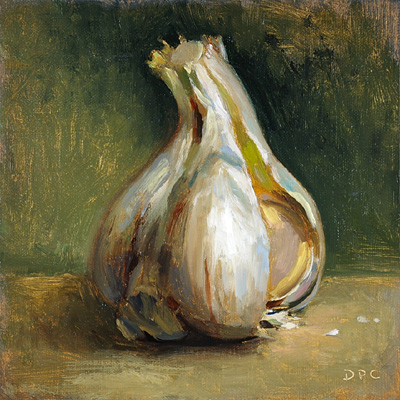
7/13. Elephant garlic, oil on linen on panel, 5x5 in.
Lately as I struggled to mix the right colors - say, decent shades (or tints?) of neutral gray - I would think about what I "knew" so far of how English-speaking people a thousand years ago would have thought of colors. I had a vision of their world (or the world they wrote about) that was tainted by all I had read on the subject, and I'd accepted the view put forth by some scholars that Old English color terms not only stressed brightness over hue, but also denoted aspects of surface texture or reflectivity. Basic-level color names then were taken to mean also dull or glossy or shining or glimmering, and so on and so on - to the point that I carried around this image of an "ideal" Anglo-Saxon world that was in half-shadow yet had very clear glints here and there of spearpoints, flickering sword edges, and dull-gleaming helmets - a diorama whose details were sharply defined though kept at an unfathomable distance behind layers of dark, honeylike varnish. Just reading about anything related to Old English felt like focusing a microscope on an amber-encased world of smoky, raucous mead halls on one hand and silent, glittering swans on the other; a world of shimmering gold and ivory contrasted against bloodstains and dark, colorless ocean.
So in that world, somehow "brown" (brún) when talking of metal could also be translated as "shining" or "bright" or "flashing," the actual hue of a brown (and dark) sword often being disregarded even by some recent translators in favor of some shine-oriented meaning. Examples from Beowulf:
How could the color brown, which was often used as a synonym for dark even into modern English, also mean bright? (It was just part of an evolutionist theory of color perception, as I'll get to below.) One etymological explanation was that there might have been confusion at some point in the evolution of the Germanic word with a similar sounding verb meaning "to burn/fire," which could have resulted in brún having two opposite meanings. But if, as in these examples, the word suggested that objects of weaponry and armor had been burned or fired, then the resulting appearance would still be dark and not bright. A more down-to-earth explanation is that brown actually described the dark coating on steel that had undergone the process of "browning" to make it less vulnerable to rust. So it seems it was a hue term after all. And as it does today, brown ranged into lighter hues such as that of parchment, though it wasn't until the 18th century that it earned a place among "basic" colors and was no longer a subcategory of black.seax getéah / brád, brún-ecg
"drew her knife, broad and bright-edged" (E. Talbot Donaldson, 1966)
"pulled out / a broad, whetted knife" (Seamus Heaney, 2000)sío ecg gewác / brún on báne
"the edge failed, bright on the bone" (Donaldson)
"the blade flashed and slashed" (Heaney)brún-fágne helm
"the bright-shining helmet" (Donaldson)
"the burnished helm" (Heaney)
I summarize this last bit from a great book, Earl Anderson's Folk-Taxonomies in Early English (2003), which is chock full of this kind of semantic analysis - I love the interlibrary loan system, by which you can get your hands on expensive books on arcane subjects for only the cost of postage, like it was a movie from Blockbuster; and Google Books, where I found the book in the first place (and where you can read much of it for free). I can't go too far before it just shows my need to read more, but for background I'll attempt to paraphrase some of it here.
Anderson defines a folk-taxonomy as "a hierarchical semantic system that lexicalizes a domain in human experience or in nature, such as colors, plant and animal life forms, seasons of the year, directions, or the senses." So, speaking of the semantic field of color (as our culture thinks of it), at the top of the hierarchy would be the taxonym, or general term, "color." At Level I are the so-called basic color terms, followed by Level II secondary color terms, Level III specialized colors, and so on. Following Anderson's example:
(0) Taxonym - colorWe are familiar with the notion of a supposedly "scientific" and unbiased color space representing hue, brightness, and saturation, but as Anderson sees it, "The scientific account is really just a refined elaboration of the modern western European concept of color." He adds that terms such as "piebald, pinto, and palomino cannot be described in terms of the scientific account of color. The expected response to this objection is that these are the names of patterns, not colors, but this is really only a way of marginalizing data that are inconsistent with a preconceived theory." He cautions that when trying to interpret an unfamiliar color system, it may not always be possible to make neat correllations to our way of seeing: "It might be misleading to assume that color terms in Old English are always lexicalizations or 'mappings' of the canonical trinity of hue, brightness, and saturation."
(1) Level I, basic - black, white, red, green, yellow, blue, brown, gray, purple, orange, pink, and possibly silver
(2) Level II, secondary -
crimson, scarlet, vermillion as species of red
maroon as species of red or brown
magenta as species of red or purple
aquamarine, turquoise as species of green or blue
etc.
(3) Level III, specialized -
Compounds like blue-green, red-orange, etc.
Comparative expressions like ash(-gray), chestnut, fireman-red, mahogany, etc.
Terms restricted to specialized semantic fields, like auburn, blonde, brunette; bay, palomino, pinto, roan, sorrel; ruddy, sallow, wan, etc.
(4) Level IV, more specialized, commercially coined terms used in automobile, cosmetics and paint industries, etc.
According to "mapping" theory, "languages are 'maps' of reality, and, although these 'maps' may differ from each other, they all relate to the same reality." Such a theory "assumes the intertranslatability of languages, such that anything said in one language can be said in another" - but anyone who knows a second language or has tried to translate between the languages of significantly different cultures knows this isn't true. Anderson therefore suggests that a language works not as a map of our universe, but of a sort of parallel universe. "Words do not relate directly to things as symbolic mappings, but they relate to each other in semantic patterns and systems that are approximately parallel to the interrelation of things in reality." We may also believe in the sufficiency of our language, but, however large a language's color vocabulary, there will always be a "poverty of names;" no language is sufficient enough to communicate everything and leave no semantic gaps.
To the hue-brightness-saturation color model, Anderson adds a fourth aspect: "focality." Folk-taxonomies (colors, plants, animals etc.) aren't all-inclusive hierarchies "capable of 'containing' all conceivable instances of a given category." Although, like scientific taxonomies, they are attempts to impose order on a messy world, they belong to linguistics and not science. He argues that the mind is less like a container and more like a searchlight, so we seek the places on which to focus. Focalizations vary across cultures, and across time, as the result of changes in material culture and the influence of other languages. Some cultures today focalize more or fewer basic colors than we do, and Anderson notes for example that Russian has two basic terms for blue, a "dark blue" and a "sky blue," both having equal significance in the color taxonomy (i.e., neither is a subcategory of the other); Hungarian has two reds, "a light red with a focus on orange-brown" and "dark red with a focus close to purple." Many cultures have what we call macrocolors, or more than one color categorized as one - the Dani people of Papua have only two basic color terms, a "macroblack" and "macrowhite."
Anderson says, however, that "the scientific account [of hue-brightness-saturation] is an excellent representation of concepts underlying the folk-taxonomy of color in modern English." So it is useful to us as a means to compare, e.g., the Old English color system with our modern English one. But again, we go wrong if we think that our only problem lies in matching names. That is, despite the familial relation between modern and Old English, our modern map* isn't congruent with the old one.... And this takes me back to what I had previously considered true about Old English colors. Today it is still assumed that the Old English terms stressed the colors' brightness/darkness or surface components, but why was that? And, on the other hand, so what? - I mean, how does changing from this incorrect interpretation ultimately affect how we see their colors?...
__________
*On the subject of maps, it is interesting to see how the Enlightenment gridwork system of cartography used by Lewis and Clark differed from the method used by the Indians they encountered. One system gives a direction-oriented and supposedly all-inclusive view from above, the other a route-oriented diagram showing many directions at once as well as relative distance and the importance of landmarks encountered along the route (features shared by today's subway diagrams).
Posted by
Dan P. Carr
at
6:07 PM
4
comments
![]()
Tags: daily painting, food, history, miscellanea, Old English, poetry, translation, words
Friday, July 25, 2008
Mangosteen

6/12. Mangosteen, oil on linen on panel, 7x5 in. SOLD
So it was maybe because I had this disappointment fresh on my mind, or I was worried that it was too expensive a fruit to have sit unrefrigerated for too long, but I think I began the painting hurriedly and ended up laboring too much on it, getting caught up in the shell-like hardness of the skin and the shifting colors. Not that it doesn't capture the feel of a mangosteen, but I feel the painting was slightly tainted by my feelings toward the thing.
Perhaps it was fortunate that at about this time I did some more little pieces for Cameron Gray (his new show at Robert Berman Gallery in Santa Monica opens tomorrow the 26th). It's interesting to see where my little tiles end up within a picture - in this piece from March (click "all sizes"), one of the more explicit ones forms the bright white of the girl's right eye. In all there are six tiles of mine - here's one detail. (Thanks to "C-Monster" for those Flickr photos.) Some of the recent ones, more innocent:
Posted by
Dan P. Carr
at
11:45 PM
1 comments
![]()
Tags: daily life, daily painting, food, miscellanea, shows
Thursday, June 26, 2008
Easy (rotisserie) chicken noodle soup recipe

Grocery store rotisserie chickens are a pretty good deal, considering that you can get a lot of use even from their scraps. Here's a simple recipe, culled from several sources, for when that chicken in your fridge is on its last legs. Overall time if I figured it all correctly: 50-55 minutes.
Once in a while I love a cool and challenging recipe, but I'm no gourmet - more like a lazy (and cheap) gourmand. This chicken noodle soup is so easy I daresay any yahoo can make it and come off looking like a fancy-pants. To date it's the only kind I've attempted from scratch, or mostly from. What's great about this method is that it cuts out the hours-long process of making a proper stock, but it tastes like you spent all day and is more satisfying than I can describe. I've made it quite a few times now and I'm proud to say my two-year-old absolutely loves it (and loves to get it all over her). If you like, you can add to it whatever half-empty bag of veggies happens to be sitting lonely in the freezer. It's about leftovers and is really versatile, you get the idea....
Note: This soup isn't exactly diet-friendly as it leaves in all the yummy goodness (=fat). To take half the day letting it cool so you can skim off the fat would defeat the purpose of this "fast" recipe.
Ingredients:
1 leftover store-bought rotisserie chickenIn a large stockpot, bring water and broth to a simmer over medium-high heat.
½ bag (6 oz.) extra wide egg noodles
2 quarts chicken broth (boxed/canned or from bouillon) + 1 quart water
2 big onions, diced
2 big carrots, peeled and sliced into rounds or half-rounds
2 big celery stalks, sliced
4 or more garlic cloves
2 tsp. fresh or dried thyme leaves
1 bay leaf
2 T. vegetable oil
salt and pepper
2 quarts is a lot of broth (for us) to have on hand, so I keep a jar of bouillon, e.g. Herb-Ox, or some other chicken soup base for making this recipe. If going that route, then per their directions (1 tsp. bouillon for every 1 cup water) that's 8 tsp. bouillon to make the 8 cups (2 quarts) of broth, or 2 T. + 2 tsp. bouillon. Which is just shy of 3 T., to keep things simple. Bring all of the water (3 quarts total) to a boil before adding the bouillon.
While the water is going, separate the remaining white meat from the chicken bones and skin and reserve this meat in the fridge.
To the simmering broth add the chicken bones with skin, pope's nose (or parson's/sultan's nose) and whatnot - the more chickeny stuff the yummier the soup. Drop in the bay leaf, and a couple or three or more cloves of garlic, lightly smashed (I like to throw a lot of garlic in as this is a good place to use up some of the little puny cloves that tend to accumulate). Add also 1 tsp. of the dried thyme and/or other compatible herb(s), or a couple fresh sprigs if you grow it and have some to spare. Go ahead, add whatever you think would make things yummy. Reduce heat to low/medium-low, partially cover and let simmer about 30 minutes.
Meanwhile, chop up the onions, carrots, and celery; mince the remaining garlic, maybe 2 cloves. (It helps me to remember the number "2" for things in this recipe: quarts of broth, onions, carrots, etc.) Set all this aside, but here if you have any usable onion scraps, or those little center stalks of celery and especially the celery leaves, make sure to add those to the pot.
When the broth has cooked and become extremely yummy-smelling, pick out the larger bones and scraps, then carefully strain it through a colander into a large container or second pot (I line the colander with paper towels to help filter). Set this broth aside. Return main pot to the burner with heat raised to medium/medium-high.
Add oil, then the onions, carrots, and celery. Season well with salt and/or pepper. Stirring often to avoid browning, sauté until it just begins to soften, about 7-8 minutes; with a couple of minutes left add the minced garlic. Don't cook longer than this or the onions will become too sweet (you want only a hint of sweet).
Return broth back to the pot and bring back up to a boil. Add the egg noodles and boil according to the directions on the package, usually about 8 minutes. (If adding other vegetables I would probably do so at this point.)
Turn off heat, stir in the reserved chicken meat and remaining thyme leaves, and let it all hang out and become yummy together until it's time to eat.
Serves 8.
Posted by
Dan P. Carr
at
5:07 PM
4
comments
![]()
Tags: daily life, miscellanea, recipes
Tuesday, June 10, 2008
Red onion

6/8. Red onion, oil on linen panel, 7x5 in.
I began to understand just before this painting what the difference between Mars and ivory black is. I never really thought much about black, always treating it as a minor hue (though it's not really a hue) unlike in the limited palettes where it plays a very major role; sometimes I'd use it only for making an already dark color blacker. (Usually when I said "black" I meant Mars, always believing it to be darkest.) Though I say Mars is blacker overall - i.e., it's opaque and stronger - ivory black is actually blacker, i.e., darker. The main difference is that ivory black is semi-transparent. So I thought, with my palette's dark hues being transparent (or semi-), would I generally want to go to a black that is semi-transparent as well?
I assumed mixing a transparent black with already transparent darks wouldn't have any real additive effect. In fact I didn't think about the subtractive effect it would have, i.e., the paint being too oily - as can be seen in the upper background of this painting, which was the result of switching to ivory black for a mix. Putting some Mars black in it towards the bottom made it stronger, but I left it mostly as it was here because it was interesting.
Posted by
Dan P. Carr
at
11:08 PM
2
comments
![]()
Tags: daily painting, food, palette
Sunday, June 8, 2008
Palette variation
Robert Gamblin puts palettes in three categories. I find a combination Impressionist/Renaissance palette, or at least my particular variation, appealing. Since learning from Jeff how to use a wide Impressionist spectrum, I've thought a palette should be able to approximate most other colors, hence the idea of a standard palette - I'd rather rely on the same tubed colors every time than get out different tubes for different paintings (and maybe save some money). That's just me.
I kept versatility in mind as my standard colors evolved over the past year. Most recently I added two more to the lineup that are just mixes of existing ones, so that it looked like this:

1. white
2. cad. yellow light
3. ochre
4. Indian yellow
5. cad. red medium
6. alizarin
7. transp. red oxide
8. (transp. red oxide + ultramarine) = blue-brown
9. ultramarine
10. (transp. red oxide + Prussian blue) = blue-green
11. Prussian blue
12. black
The two mixes (8) and (10) are ones I found myself using a lot, so one day I finally made big batches and tubed them. At first I disliked the idea of having a total of 12 colors again, but I came to find here a simple pattern where the odd numbered ones are dominant. And though they're no longer all pure hues, the two mixes seem pure enough (being made of strong-tinting transparent or semi-transparent hues) - and they act as variations of traditional burnt umber and viridian, perhaps.
Within each group of primaries there is a cool and a warm (one opaque and the other transparent or semi-transparent); except in the blues, both of which I suppose are considered warm, Prussian however being cooler. There are also an earth yellow (ochre), an earth red, and a cool dark earth. There's something of a system in it.
The odd-number pattern I thought would help me to simplify a little - e.g. in the very beginning stages of a painting use just (1), (3), (7) and maybe (9), and simple mixes resulting from them (with (8) being one such mix already) - except I tend to get ahead of myself when painting and haven't been able to stick to that plan. Still, the idea was an interesting one.
* * *
I thought if a paint manufacturer can simulate colors like Naples yellow, then so could I:
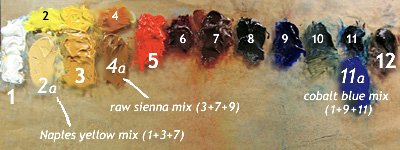
Here the numbers are the same as above with emphasis now on the seven-color scheme just mentioned, the only actual new kids on the block being (2a), (4a) and (11a). No great changes took place, except obviously the new colors share space with their counterparts in the original lineup. I used the little space between cad. yellow light(2) and Indian yellow(4) to show how a range of bright middle yellows might exist there (the transparency of Indian yellow makes it so versatile).
A Naples yellow "hue" might be manufactured with white plus some yellow and/or reddish iron oxides, and is easy for me to replicate using ochre (a natural iron oxide) and a touch of transparent red oxide (a synthetic). Raw sienna, another natural iron oxide, can also be approximated with the red oxide and ochre, here with a tiny bit of ultramarine - this is incidentally a mix I occasionally used to use, which could be made to lean slightly towards towards green or red.
Of course these are just my versions and some people might mix them differently. And one might feel there is a sort of blasphemy going on, as you can't really get close to the "true blue" of cobalt using Prussian blue and ultramarine. I remembered the cheap student-grade tubes of cobalt blue "hue" I learned to paint with and how they contain, along with the wax fillers, a mix of white, ultramarine and phthalo blue pigments. My justification for using the slightly weaker Prussian blue for phthalo was in knowing that they are otherwise nearly interchangeable (phthalo having been invented to replace Prussian). And despite the less-than-true-blue quality, this mix (like my "raw sienna") is good because of its strong transparent components. (I'd prefer anyway not to have the bite of true cobalt on my palette, just as I wouldn't want something like a cadmium orange, as beautiful as they are.)
So what did this little exercise show? Just that I could combine two color palettes into one without a great deal of reorganization. I'm not sure yet how much better this will help me to see but it was worth doing.
Posted by
Dan P. Carr
at
12:54 AM
1 comments
![]()
Tags: materials, miscellanea, palette
Thursday, June 5, 2008
Avocado #4

6/3. Avocado #4, oil on linen panel, 5x7 in. SOLD
I don't have a good studio set-up with sunlight through a window; I had constructed a thing recently sort of like a photographer's macro light box/tent, using a white cloth to soften the light - something I had been thinking about coincidentally about the time I read Paul's comment way back - but I can't say yet how effective it is. Here I shone my lamp through a white trash bag.
Posted by
Dan P. Carr
at
7:19 PM
1 comments
![]()
Tags: daily painting, food, miscellanea
Strawberries



5/19 - 5/22. Strawberries, oil on linen panel, 5x5 in.
These strawberries were still only halfway posted in "draft" limbo, when I saw the other day that my old teacher Jeff had done some as well. I can't say how good it feels to see his paintings online. It really takes me back. Not that he paints the same as I remember - in fact he described his recent Florence-influenced palette to me and it got me thinking differently about my own thinking. With Gary online as well I said it felt like we are walking the same halls again. The Internet is wonderful.
This painting is not illustrative of any new thinking, but rather how I haven't been doing much thinking while painting. I decided to take the in-progress shots of this piece when as soon as I realized I was having trouble with it, and if this is any lesson it shows how one could do things better in the beginning. These sessions were perhaps under a couple of hours each, plenty of time really, but the first night I failed to get the shapes right and I wasn't paying attention to even the basic light and shadow masses of the strawberries. Plus I got too much white/grey in everything.
The next night I tried to do better but still lacked focus - if you're like me, you sometimes do something without being wholly aware along the way, especially when you pre-suppose it to be easy - you can't paint subconsciously and effectively, apparently (at least in my case) not strawberries. The reds were giving me a hard time as always, and I knew everything had to be drawn better and I couldn't get around that. By this time the leaves were changing shape and mold had begun to show in places, which was upsetting because this batch of giant strawberries was probably the sweetest I've ever tasted.
I wanted to abandon the piece but a couple of nights later I went back into it. This time I arrived at a better sense of the form. Things finally were feeling round and I had had enough. I touched up the shadow area a little just before taking the last photo, but managed to somehow seriously mess up the darker red parts. So I was forced to unify the whole shadow area the way I should have in the first place - and it actually looks better, even if the end product is kind of stiff I think.
Posted by
Dan P. Carr
at
3:20 PM
1 comments
![]()
Tags: food, miscellanea, work in progress
Wednesday, June 4, 2008
IC14 Show
Well, back to the Illustrators Club show. The gallery that evening was packed and hot and stuffy and I was nervous and sweaty and feeling more un-photogenic than usual, so I'm not in these pictures. Really I was just happy to be there.
I am sorry that all I documented of the event centered around people looking at my piece (or not looking, as that's a gold medal winner by the awesome Greg Harlin they're admiring):
But I did catch these guys taking a closer look:
I was so proud to be in this group, knowing I was a small fish in the pond. And hey, my name was mentioned in last Friday's Washington Post review!
Posted by
Dan P. Carr
at
3:55 PM
0
comments
![]()
Tags: illustration, miscellanea, shows
Wednesday, May 7, 2008
Illustrators Club show!

Happily in the time I was "away" some good things came along, one being the news that this little piece was accepted in the Illustrators Club of DC, MD & VA's annual juried show, and we're planning to drive up for the opening tomorrow (sorry I'm posting this at the last minute).
For now I'll say some other stuff is in the works too, which makes me think that Yeats' old crane of Gort may himself be enjoying a trout or two....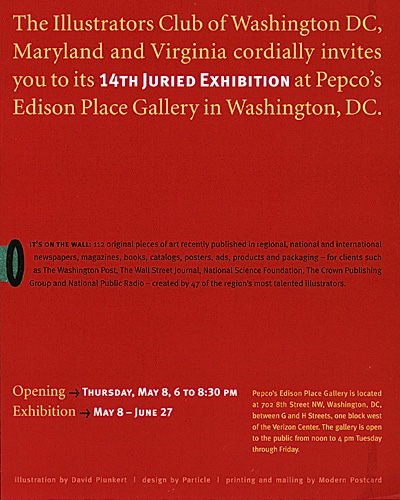
Posted by
Dan P. Carr
at
3:25 PM
6
comments
![]()
Tags: illustration, miscellanea, shows
Management profoundly regrets and apologizes for the inconvenience and worries that have been caused; and Eddoes #2
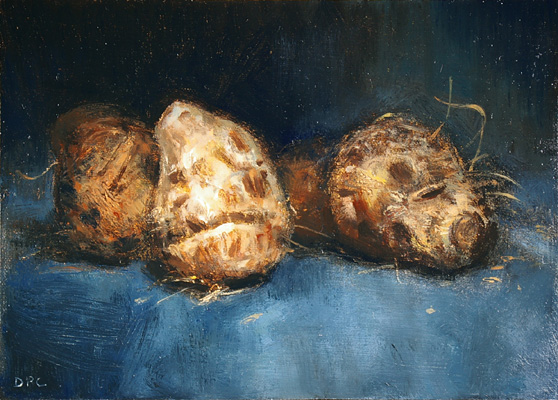
5/6. Eddoes #2, oil on linen on panel, 5x7 in.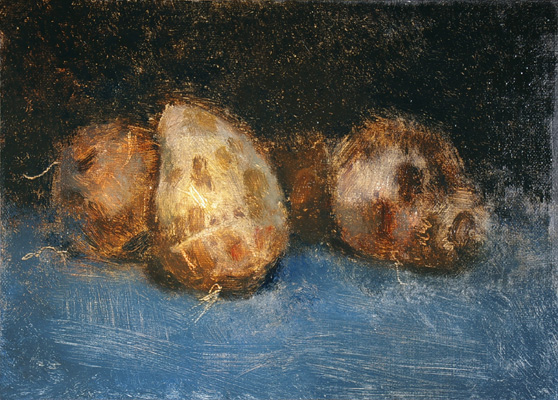
(in progress)
Well, I never thought I'd become one of those loathsome, horribly selfish people who could let their blogs languish for months with no explanation why. Originally I intended to stop for some soul-searching (whatever that means). I felt that I had been working too comfortably, that I still wasn’t getting at whatever it is I wanted to get at, if you get that. Most likely it started with my going to Charleston and seeing my friend and coming back and seeing a lot more great art online and getting annoyed with myself and with how I see (or don’t see) things. The old hermit in me said it was time to step away and hide out for a while, so I decided to put this (almost-)daily painting "project" face down and not feel too guilty about it.
I was telling myself I had to work out the composition of a new portrait of my daughter. Looking again at my old art history books reminded me of the enormous impact that Correggio, Bellini, and other Renaissance painters initially had on me, and it made me want to tackle something on a little larger scale in which I could play around more with light, do more subtle things. But I maybe just got more overwhelmed looking at more good stuff. And that portrait of Breagha never got started.
As my friend Gary put it, sometimes "life happens" - I found myself sidetracked by non-art projects (e.g. building a shoe rack for the narrow space by our front door, putting up some shelves, rearranging our computer work area). At some point though I helped do some tiny paintings for an artist in Southern California named Cameron Gray, who puts together these large mosaics with photos of body parts, food, and such things as reference (see a past show). Here are some:
My hiatus hadn't exactly been a vacation, though I must say it has been nice after the kid's in bed to once in a while spend the rest of the evening in the same room with my wife, and not at my easel. And a lot of times I would get lost in a book about falconry or abstruse Old English stuff (which relate to the portrait I want to do), but sometimes I'd just watch news and get mad at the political coverage, which just meant that I was in a worse comfort zone and that I needed to get back. Time the dragon awoke and came out of his barrow....
So, back to the eddoes above - I can’t remember when, but one night at least two months ago I had started painting them, and they then sat there patiently waiting to recapture my attention. So the other night I finished the painting - though by this time the little things had shriveled considerably (getting moldy underneath) and were sprouting real thick, sharp-looking green shoots. It was hard to overlook their present condition and rely more on my memory for some details, but I did my best.
Posted by
Dan P. Carr
at
3:05 AM
1 comments
![]()
Tags: daily life, daily painting, food, miscellanea, shows, work in progress



